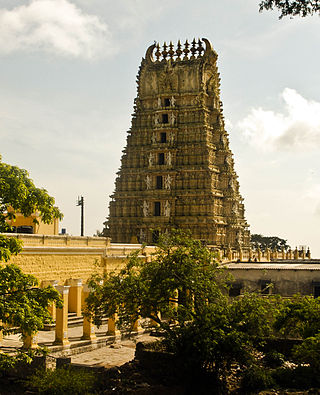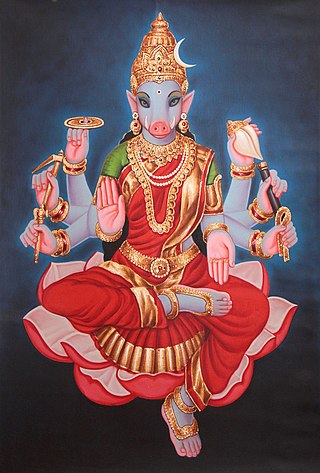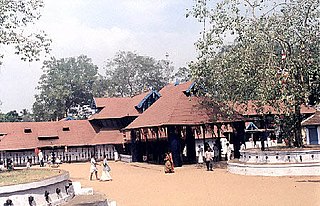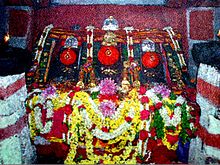
Bhavānī is a manifestation of Adi Shakti (Durga). Bhavani translates to "giver of life," meaning the power of nature or the source of creative energy. She is considered to be a mother who provides to her devotees and also plays the role of dispensing justice by killing Asuras.
Azhakodi Devi Temple or Azhakodi Devi Mahakshethram is a Hindu temple located in Thiruthiyad, Kozhikode District, Kerala, South India. It is one of the famous Devi temples, situated hardly 1.5 km away from the Mofussil Bus stand and 2.5 km from the KSRTC Bus stand, the area still retains the beauty and charm of un-spoilt rural settings within the heart of the Kozhikode city. The temple and the Kalayana Mandapom are administered by the Malabar Devaswom Board.
The Saptha Kannimar Padal is one of the sub-sections of Arul Nool which was the secondary scripture of Ayyavazhi. This follows the concept of Saptha Kanya.The author of the content is unknown. This contains the event's background and reason for the birth of the seven virgins in the world. Below are the names of Saptha Kannimar:
- Brameshwari
- Kaumari
- Varahi
- Vaishnavi
- Chamundi
- Maheshwari
- Indrani
Matrikas (Sanskrit: मातृका (singular), IAST: mātṝkā, lit. "mothers") also called Matar or Matri, are a group of mother goddesses who are always depicted together in Hinduism. The Matrikas are often depicted in a group of seven, the Saptamatrika(s) (Seven Mothers). However, they are also depicted as a group of eight, the Ashtamatrika(s). In the Brihat Samhita, Varahamihira says that "Mothers are to be made with cognizance of (different major Hindu) gods corresponding to their names." They are associated with these gods as their spouses or their energies (Shaktis). Brahmani emerged from Brahma, Vaishnavi from Vishnu, Maheshvari from Shiva, Indrani from Indra, Kaumari from Kartikeya, Varahi from Varaha and Chamunda from Chandi. and additionals are Narasimhi from Narasimha and Vinayaki from Ganesha.

The Chamundeshwari Temple is a Hindu temple located on the top of Chamundi Hills about 13 km from the palace city of Mysuru in the state of Karnataka in India. The temple was named after Chamundeshwari or, the fierce form of Shakti, a tutelary deity held in reverence for centuries by the Maharaja of Mysuru.

Shree Tulaja Bhavani Temple is a Hindu temple dedicated to goddess Bhavani. It is located in Tuljapur in Dharashiv district of Maharashtra, India, and is considered as one of the 51 Shakti Pithas. It is situated 45 km from Solapur. The temple was built in 12th century CE by Maratha Mahamandaleshwara Māradadeva of the Kadamb dynasty.

The Siddhesvara Temple is located in Haveri in Haveri district, Karnataka state, India. It is considered an ornate example of 12th-century Western Chalukyan art and is well known for the many loose sculptures of Hindu deities that exist in it. However, inscriptional evidence would suggest that the initial consecration of the temple was in the late 11th century. An exciting aspect of the temple is that it faces west instead of facing the rising sun in the east–a standard in Chalukyan constructions. Though it is currently used as a Shaiva temple dedicated to God Shiva, historians are unsure by which faith or sect the temple was consecrated initially and to which deity. Many people visit the temple for their spiritual beliefs, while evidence about temple visits can be found in Gita chapter 17, verse 23, which says otherwise. Most of the Lord Shiva sculptures are observed to be of him meditating. There are claims that he meditates on himself, whereas some proof can be found in Devi-Bhagavata Purana that Lord Shiva meditates for some other God. This uncertainty perhaps stems from the many loose sculptures of deities and the degradation of primary wall images.

Varahi is one of the Matrikas, a group of seven mother goddesses in the Hindu religion. Bearing the head of a sow, Varahi is the shakti of Varaha, the boar avatar of the god Vishnu. In Nepal, she is called Barahi. In Rajasthan and Gujarat, she is venerated as Dandini.
The Meenkulathi Temple is located in Pallassena, a village in southern India.

Sree Kurumba Bhagavati Temple is a Hindu temple at Kodungallur, Thrissur District, Kerala state, India. It is dedicated to the goddess Bhadrakali, a form of Mahakali or simply Durga or Aadi Parashakthi worshipped and significantly revered in Kerala. The goddess is known also by the names "Sri Kurumba"". This temple is the head of 64 Bhadrakali temples in Kerala. This Mahakali temple is one of the oldest functioning temples in India. This is attested by numerous Tamil poems and inscriptions of different times. The goddess of the temple represents the goddess in her fierce ('ugra') form, facing North, featuring eight hands with various attributes. One is holding the head of the demon king Daruka, another a sickle-shaped sword, next an anklet, another a bell, among others. Routine worship at the temple every day at 03:00 and ends at 21:00 local time.

Kondathu Kaliamman Temple is an Amman temple located at Pariyur near Gobichettipalayam in Tamil Nadu, India. There are other temples, namely Sri Amarapaneeswarar Temple, Sri Adinarayana Perumal Temple and Sri Angalamman Temple nearby.
Saptamaruka Temple is Hindu temple in Jajpur in the Indian state of Odisha. Temple is dedicated to Hindu Tantric and Puranic goddesses Saptamatrikas.

Ashta Bhairavas are eight manifestations of the Hindu god Bhairava, a ferocious aspect of the god Shiva. They guard and control the eight directions. Each Bhairava has seven sub Bhairavas under him. All of the Bhairavas are ruled and controlled by Maha Kala Bhairava, who is considered the supreme ruler of time of the universe and the chief form of Bhairava.

Kalarivathukkal Bhagavathy Temple, Bhadrakali Shrine located near Valapattanam river, is the family shrine of Chirakkal Royal Family. The deity of the shrine is the fierce form of Bhadrakali. Kalarivathukkal Bhagavathy is considered as the mother of the ancient martial art Kalarippayattu and hence the name. The shrine is administered by Malabar Devaswom Board and classified as Category A Temple of the board. Kalarivathukkal has come from the word Kalari Vaatilkal.

Niranam Thrikkapaleeswaram Dakshinamurthy Temple, an ancient Hindu temple dedicated to Lord Shiva is situated on the banks of the Pampa river at Niranam of Pathanamthitta District in Kerala state in India. This temple is a classic example of the Dravidian style of architecture. The temple is the abode of Dakshinamurthy. The deity of Thrikkapaleeswaram is located in main Sanctum Sanctorum facing east. According to folklore, sage Parasurama has installed the idol. The temple is a part of the 108 famous Shiva temples in Kerala. This is one of the three Thrikkapaleeswaram temples mentioned in 108 Shiva temples. Two other temples situated in Peralassery in Kannur district and Nadapuram in Kozhikode district.
Kiruthivakesvarar Temple is a Hindu temple dedicated to the deity Shiva, located at Soolamangalam near Ayyampet in Thanjavur district in Tamil Nadu, India.
Harimukteesvarar Temple is a Hindu temple dedicated to Lord Siva located in Ariamangai of Thanjavur district, Tamil Nadu, India
Jambukesvarar Temple is a Hindu temple dedicated to Lord Siva located in Nallichery of Thanjavur district, Tamil Nadu, India

Pasupatheesvarar Temple is a Hindu temple dedicated to Lord Siva located in Pasupathikoil of Thanjavur district, Tamil Nadu, India.
Bhadwamata or Bhadvamata is a holy temple situated in the Neemuch district of Madhya Pradesh at the distance of 18km. It is a beautifully constructed marble temple of Mahamaya Bhadwa Mata.














